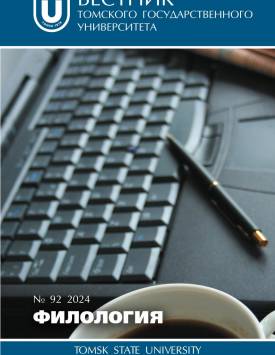Structural features of comparative phraseological units in the dialects of Russian Germans
The conducted comprehensive study aims to characterize dialect comparative constructions from different points of view: component composition, mechanism for implementing the comparison procedure that conveys the artistic features of idioms, and features of functioning in speech. An important task is to consider such phrases against the background of the common German phraseological fund. The text corpus of German dialects in Altai served as a source of material for the analysis. 205 phraseological units containing comparisons were identified by the continuous sampling method. Phraseological dictionaries of German and Russian were used for comparison. Comparative constructions of Russian-German dialects have not yet been comprehensively studied, which is the scientific novelty and relevance of the work. The structural originality of the comparative phraseological units of the German language lies in the fact that the characteristic of a property or action occurs within the framework of a comparative group or a comparative subordinate clause introduced by comparative conjunctions wie, als, als wie, als ob, wie wenn, je ... desto, which in the considered dialects are realized as wie, als wie wann, je ... je, so ... so. A total of 14 models were identified, which include 2 two-component and 12 multi-component models. The lexico-grammatical categories of comparative phraseological units correspond to the parts of speech according to the similarity of the grammatical meanings expressed by them. Comparative verbal phraseological units are always represented by a subordinating structure in which the first components retain their direct meaning, while the second components are rethought and perform the function of intensification or semantic differentiation of the first components. If adverbial comparative phraseological units include adjectives, then they are used, as a rule, in a positive degree, and nouns in the singular form, e.g., wi n nasser Hund [in a guilty way]. The first component of adj ectival comparative phraseological units is used in the main meaning, and the second one performs the function of strengthening the attribute, or indicates the degree of the attribute expressed by the first component. The studied material does not allow singling out a group of substantive phraseological units. Phraseological units can be combined with different parts of speech within statements: with a verb (der kaut wi e Hasje un schluckt wi n Wolf); adjective (dumm wi n Ochs); noun (des is n Kerl wi e Pund Worscht, s gebt meh Kette wi rasende Hunde, der hot Knoche wi Gaul); an adverb, a word of the category of state (dunkel wi im Sack). The compatibility features of phraseological units of comparison are influenced not only by the structural features of phraseological units, but also by their correlation with certain lexico-grammatical categories. The nature of syntagmatic connections with other words in a sentence determines the possibilities of compatibility of stable comparisons: to play the role of a predicate expressed by a phraseological combination, to be part of a nominal predicate, less often to act as a circumstance or definition. The authors declare no conflicts of interests.
Keywords
syntactic function of phraseological unit, structure of phraseological unit, idioms of comparison, German dialectsAuthors
| Name | Organization | |
| Moskalyuk Larisa I. | Altai State Pedagogical University | l.moskalyuk@yandex.ru |
| Moskalyuk Olga S. | Polsunov Altai State Technical University | omoskalyuk@yandex.ru |
References

Structural features of comparative phraseological units in the dialects of Russian Germans | Vestnik Tomskogo gosudarstvennogo universiteta. Filologiya – Tomsk State University Journal of Philology. 2024. № 92. DOI: 10.17223/19986645/92/4
